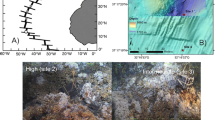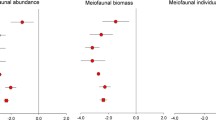Abstract
Intertidal meiobenthos of Hornsund—the southernmost fjord of Spitsbergen—was investigated between July and September 2005. Mean total meiofaunal densities ranged between 4.3 and 328 ind. 10 cm−2. Nematode assemblages were impoverished in terms of the number of genera when compared with those from the western Spitsbergen coast (11 vs. 25–28 genera in total, respectively). It is suggested that severe environmental conditions in the southern part of Spitsbergen overcome the adaptation skills of many nematode species and hamper the establishment of a diverse community. Comparatively high nematode numbers on a beach subject to heavy macroalgal wrack input contrast sharply with numerically poor communities in sparse-wrack beaches (up to 315 vs. 31 ind. 10 cm−2, respectively). It is suggested that the wrack input to the Arctic beach may substantially influence the richness and composition of the intertidal meiobenthic community. Nematode assemblages were dominated by extreme colonizers: Geomonhystera disjuncta and rhabditids. Their relatively high densities in beach sediments recorded at the beginning of July indicate their ability to recover rapidly after the winter period and to effective (re)colonization of the intertidal habitat just after the ice melt. Average concentration of rhabditids and monhysterids associated with macroalgal wrack deposited on the upper shore was as high as 52 × 103 individuals per gram of the substrate. It is hypothesized that nematodes can play a substantial role in the wrack decomposition in the Arctic intertidal.




Similar content being viewed by others
References
Alkemade R, Wielemaker A, De Jong SA, Sandee AJJ (1992) Experimental evidence for the role of bioturbation by the marine nematode Diplolaimella dievengatensis in stimulating the mineralization of Spartina anglica leaves. Mar Ecol Prog Ser 90:149–155
Alkemade R, Van Rijsvijk P (1993) Path analyses of the influence of substrate composition on nematode numbers and on decomposition of stranded seaweed at an Antarctic coast. Neth J Sea Res 31:63–70
Aller RC, Aller JY (1992) Meiofauna and solute transport in marine muds. Limnol Oceanogr 37:1018–1033
Bick A, Arlt G (2005) Intertidal and subtidal soft-bottom macro- and meiofauna of the Kongsfjord (Spitsbergen). Polar Biol 28:550–557
Bjørnsen PK (1986) Automatic determination of bacterioplankton biomass by image analysis. Appl Environ Microbiol 51:1199–1204
Blott SJ, Pye K (2001) Gradistat: a grain size distribution and statistics package for the analysis of unconsolidated sediments. Earth Surf Processes Landforms 26:1237–1248
Bongers T, Alkemade R, Yeates GW (1991) Interpretation of disturbance-induced maturity decrease in marine nematode assemblages by means of the maturity index. Mar Ecol Prog Ser 76:135–142
De Mesel I, Derycke S, Swings J, Vincx M, Moens T (2003) Influence of bacterivorous nematodes on the decomposition of cordgrass. J Exp Mar Biol Ecol 296:227–242
De Mesel I, Derycke S, Moens T, Van der Gucht K, Vincx M, Swings J (2004) Top-down impact of of bacterivorous nematodes on the bacterial community: a microcosm study. Environ Microbiol 6:733–744
Elmgren R (1973) Methods of sampling sublittoral soft bottom meiofauna. Oikos Suppl 15:112–120
Epstein SS, Rossel J (1995) Enumeration of sandy sediment bacteria: search for optimal protocol. Mar Ecol Prog Ser 117:289–298
Forster SJ (1998) Osmotic stress tolerance and osmoregulation of intertidal and subtidal nematodes. J Exp Mar Biol Ecol 224:109–125
Gerlach SA (1965) Freilebende Meeresnematoden aus der Gezeitenzone von Spitzbergen. In: Gerlach SA and Hohnk W (eds) Veröff Inst Meeresforsch Bremerhaven, vol. 9, pp 109–172
Inglis WG, Coles JW (1961) The species of rhabditids (Nematoda) found in rotting seaweed on British beaches. Bull Br Mus (Natural History) 7:320–333
Mielke W (1974) Eulitorale harpacticoidea (Copepoda) von Spitsbergen. Mikrofauna Meeresboden 37:161–210
Moens T, Vierstraete A, Vincx M (1996) Life strategies in two bacterivorous marine nematodes: preliminary results. PSZNI Mar Ecol 17:509–518
Moens T, Vincx M (1997) Observations on the feeding ecology of estuarine nematodes. J Mar Biol Assoc UK 77:211–227
Moens T, Verbeeck L, Vincx M (1999) Preservation- and incubation-time induced bias in tracer-aided grazing studies on meiofauna. Mar Biol 133:69–77
Moens T, dos Santos GAP, Thompson F, Swings J, Fonsêca-Genevois V, De Mesel I (2005) Do nematode mucus secretions affect bacterial growth? Aquat Microb Ecol 40:77–83
Mokievsky VO (1992) Composition and distribution of intertidal meiofauna of Isfjorden, West Spitsbergen. Pol Polar Res 13:31–40
Palmer M (1988) Dispersal of marine meiofauna: a review and conceptual model explaining passive transport and active emergence with implications for recruitment. Mar Ecol Prog Ser 48:81–91
Platt HM, Warwick RM (1983) Freeliving marine nematodes. Part I. British Enoplids. In: Kermack DM, Barnes RSK (eds) Synopses of the British fauna (New Series), No. 28. Cambridge University Press, Cambridge, p 307
Radziejewska T, Stañkowska-Radziun M (1979) Intertidal meiofauna of Recherchefjorden and Malbukta, Vest-Spitsbergen. Sarsia 64:253–258
Ronowicz M (2005) Species diversity of Arctic gravel beach: case study for species poor habitats. Pol Polar Res 26:287–297
Siwecki R, Swerpel S (1979) Oceanographical investigations in Hornsund, 1974–1975. Oceanografia 6:45–58
Szymelfenig M, Kwaśniewski S, Węsławski JM (1995) Intertidal zone of Svalbard 2. Meiobenthos density and occurrence. Polar Biol 15:137–141
Tietjen JH, Lee JJ, Rullman J, Greengart A, Trompeter J (1970) Gnotobiotic culture and physiological ecology of the marine nematode Rhabditis marina Bastian. Limnol Oceanogr 15:535–543
Traunspurger W (1997) Bathymetric, seasonal and vertical distribution of feeding types of nematodes in an oligotrophic lake. Vie Milieu 47(1):1–7
Ullberg J, Olafsson E (2003) Effects of biological disturbance by Monoporeia affinis (Amphipoda) on small-scale migration of marine nematodes in low-energy soft sediments. Mar Biol 143:867–874
Urban-Malinga B, Kotwicki L, Gheskiere T, Jankowska K, Opaliński KW, Malinga M (2004) Composition and distribution of meiofauna, including nematode genera in two contrasting Arctic beaches. Polar Biol 27:447–457
Urban-Malinga B, Wiktor J, Jabłońska A, Moens T (2005) Intertidal meiofauna of a high-latitude glacial Arctic fjord (Kongsfjorden, Svalbard) with emphasis on the structure of free-living nematode communities. Polar Biol 28:940–950
Urban-Malinga B, Moens T (2006) Fate of labile organic matter in Arctic intertidal sediments: is utilization by meiofauna important? J Sea Res 56:239–248
Vincx M (1996) Meiofauna in marine and freshwater sediments. In: Hall GS (eds) Methods for the examination of organismal diversity in soil and sediments. CAB International, Wallingford, pp 187–195
Warwick RM, Platt HM, Somerfield PJ (1998) Free-living marine nematodes. Part III. Monhysterids. In: Barnes RSK, Crothers JH (eds) Synopses of the British fauna (New Series), No. 53. Field Studies Council, Shrewsbury, p 296
Węsławski M, Wiktor J, Zajączkowski M, Swerpel S (1993) Intertidal zone of Svalbard. 1. Macroorganism distribution and biomass. Polar Biol 13:73–79
Wieser W (1953) Beziehungen zwischen Mundhhlengstalt, Ernahrungsweise und Vorkommen bei Freilebenden marinen Nematoden. Ark Zool 2:439–484
Acknowledgments
This study was possible thanks to the facilities of the Polish Polar Station in Horsnund. The crew of the Station is gratefully acknowledged by the first author for hospitality and providing meteorological data. Marcin Węsławski is acknowledged for support and Aleksandra Swistulska for help at the field work. Katarzyna Jankowska helped with the sampling in September. Organic carbon and nitrogen content were measured by Dorota Burska. Jan Matuła and Bronisław Wojtun are acknowledged for a company and nice working environment. Three anonymous referees are gratefully acknowledged for valuable remarks and suggestions which helped to improve the manuscript.
Author information
Authors and Affiliations
Corresponding author
Rights and permissions
About this article
Cite this article
Urban-Malinga, B., Drgas, A., Ameryk, A. et al. Meiofaunal (re)colonization of the Arctic intertidal (Hornsund, Spitsbergen) after ice melting: role of wrack deposition. Polar Biol 32, 243–252 (2009). https://doi.org/10.1007/s00300-008-0525-x
Received:
Revised:
Accepted:
Published:
Issue Date:
DOI: https://doi.org/10.1007/s00300-008-0525-x




